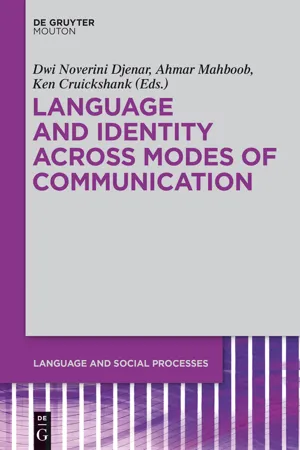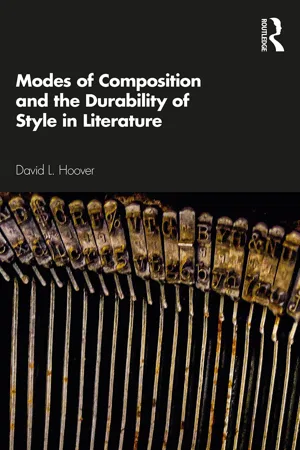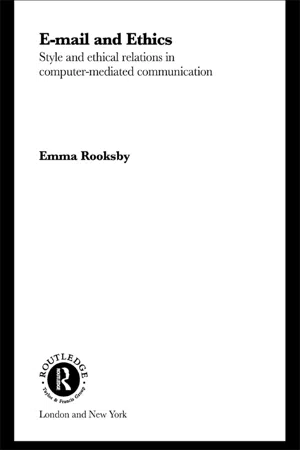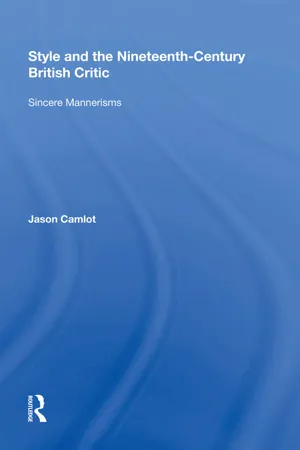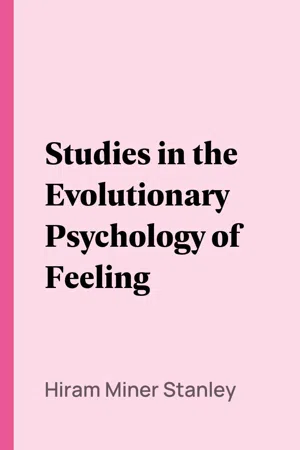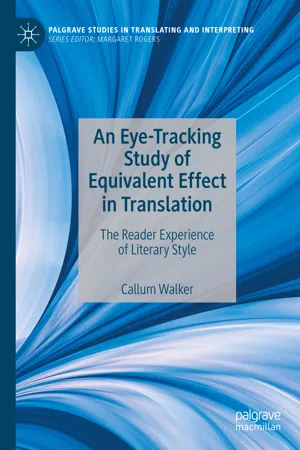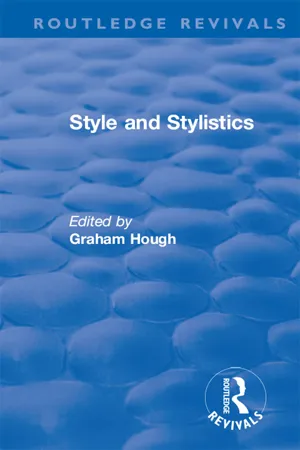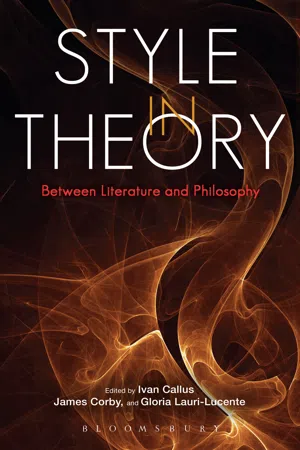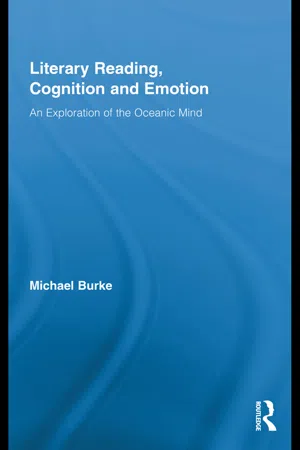Literature
Style
In literature, "style" refers to the way an author uses language to express their ideas and create a unique voice. It encompasses elements such as word choice, sentence structure, and tone, which contribute to the overall aesthetic and impact of the writing. A writer's style can greatly influence the reader's experience and interpretation of the text.
Written by Perlego with AI-assistance
Related key terms
Related key terms
1 of 4
Related key terms
1 of 3
12 Key excerpts on "Style"
- Noël Carroll, John Gibson, Noël Carroll, John Gibson(Authors)
- 2015(Publication Date)
- Routledge(Publisher)
17Literary Style1Wolfgang Huemer DOI: 10.4324/9781315708935-17I Dimensions of “Style”
It should come as a surprise that the notion of Style is elusive: after all, Style is often taken to pertain to the surface (rather than the substance) of a (literary) work of art. The elements of Style should, thus, lie open before our eyes and be easy to discern. Moreover, we all seem to have a clear intuitive understanding of Style: we know that it is essential to the aesthetic dimension of a work and makes it accessible for aesthetic appreciation, we are familiar with the idea that it allows us to attribute a work to an author, a genre, a school, or a period, and might even think that it reveals the artistic personality of the author. Yet we find that there is no universally accepted definition of “Style.” Moreover, the numerous definitions that have been proposed in the past highlight very different aspects that often stand in contrast to one another, which shows that Style has many faces, is rich of different dimensions and performs a great variety of functions: it has been characterized as a “dress of thought” that adorns a pre-existing content; as a choice between alternative expressions; as a set of recurrent, individual, or collective characteristics; as signature; as an expression of the author’s personality; as a way of writing dictated by rules or an acquired disposition to act on a set of rules; but also as a systematic violation of rules or deviation from a norm; it is taken to be an expression of originality, to manifest a perspective or point of view, or to foreground the possible uses of a medium and so to draw our attention to the workings of language.Etymologically the word “Style” refers to manners of linguistic expression. It is derived from the Latin “stilus” that stands for “a stake or pale, pointed instrument for writing, oral or written Style” (The Oxford English Dictionary 1989), but its meaning has broadened considerably. Nowadays the term is used for characteristic features of groups, schools, genres, or periods in the history of art, literature, music, or architecture, etc., for ways of producing works of art or other artifacts, as in writing Style or painting Style, for Styles of reasoning, ways of performing an action, as in dance Style or swimming Style, or Style of chess playing, for phenomena related to fashion, personal outfit and lifeStyle, as in hairStyle or dress Style, for furniture or design, for ways of conducting interpersonal relations as in leadership Style, for specific formats, for manners, procedures, or skilled production processes that are typical for an individual, an institution, or a company, etc.; sometimes it is used without any further qualification—when we say that someone or something has Style- Dwi Noverini Djenar, Ahmar Mahboob, Ken Cruickshank, Dwi Noverini Djenar, Ahmar Mahboob, Ken Cruickshank(Authors)
- 2015(Publication Date)
- De Gruyter Mouton(Publisher)
Mary BucholtzThe elements of Style 1
1 Introduction
Over the past twenty years, the study of identity within the broad interdisciplinary field of sociocultural linguistics (Bucholtz and Hall 2008) has been elevated from a fringe topic to a central analytic concern. As a vital component of this shift, many scholarly perspectives on language, culture, and society have shown a renewed interest in the concept of Style. Yet what exactly is meant by Style remains an unresolved question within the field.Style has long been a key term in a number of disciplines and professions, although it is defined and used in divergent ways across these traditions, with little dialogue between different approaches. In literary criticism, for example, Style is generally conceptualized as the unique authorial voice of a literary text or an entire body of work, an issue investigated most extensively in the field of stylistics (e.g., Bradford 1997). Meanwhile, in the world of journalism and publishing, Style is a set of professionally imposed conventions regarding what is often termed the “mechanics” of writing: attribution, formatting, punctuation, and spelling (e.g., Associated Press 2011; Chicago Manual of Style 2010). Within traditional rhetoric and composition, these two general perspectives on Style are brought together, as rules of sentence structure and word choice are prescribed in order to enable novice writers, somewhat paradoxically, to achieve their own textual voice (e.g., Williams and Colomb 2011).2 Given that the same term is used both for the most idiosyncratic aspects of individual personal expression and for regimented conformity to an institutional standard, it is no wonder that even specialists have had difficulty agreeing on the scope of Style.As in these other areas, within various branches of sociocultural linguistics, there has historically been little agreement on the meaning of Style- David Hoover(Author)
- 2020(Publication Date)
- Routledge(Publisher)
can be distinguished computationally, and social constructionism does not really suggest otherwise. On the contrary, it can be seen as implying or even guaranteeing the existence of unique individual selves and Styles, though we need not be committed to the overly romanticized individual genius. Ignoring the genetic uniqueness of each human being, if the self is constructed from environmental and social influences on the growing child, that self is necessarily unique because no two humans grow up in identical natural or social environments. There is thus every reason to believe that a socially constructed individual self will inevitably result in an individual and unique set of linguistic behaviors. Each person’s idiolect is necessarily unique, and this allows for the possibility, at least, that each person’s writing Style is unique (see Love 8–10).There is neither space for an extended discussion of these issues here, nor any need for such a discussion. Pending the demonstration of the effectiveness of computational methods of stylistic analysis in identifying variations in Style in the next chapter, I will simply lay out my own views on literary Style briefly and then turn to the durability of Style and modes of composition.In its broadest, simplest, and most basic sense, Style is a way of doing something—here, an author’s way of writing. Practically, however, the normal focus of a discussion or an analysis of Style is actually the characteristics or features of texts. One recent discussion of Style defines it as “a property of texts constituted by an ensemble of formal features which can be observed quantitatively or qualitatively” (Herrmann et al. 16). That this complex ensemble of characteristic features of any author’s Style together constitutes a unique “wordprint,” analogous to a fingerprint, is a reasonable, if unprovable, assumption (Love 12; Burrows, “Not” 91).Considering Style to be a property of texts allows the term to apply to the Style of a literary-historical period (Victorian, Romantic) or genre (Gothic, satire), of an author’s complete oeuvre (Faulkner’s Style), of a chronological period within an author’s oeuvre (Henry James’s late Style), of a single text (the Style of The Great Gatsby), or even of part of a single text (Benjy’s Style in The Sound and the Fury, Holden Caulfield’s Style in The Catcher in the Rye, Elizabeth Bennet’s Style in Pride and Prejudice- eBook - ePub
- Michael Ryan(Author)
- 2022(Publication Date)
- Routledge(Publisher)
2 StylisticsDOI: 10.4324/9781003305422-3Summary of Main Ideas
- Stylistics is the linguistic study of literature. Linguists focus on aspects of language use such as deixis (the direction of a reader’s attention at selected objects or events) in storytelling. Stylistics also studies the common features of an entire body or corpus of works such as the novels of Charles Dickens to determine the most pervasive uses of language.
- A genre is a type of literature such as drama, fiction, or poetry.
- A mode is a particular way of using language. Often, a mode is associated with a specific attitude or worldview. The sentimental mode is informed by the Christian worldview, and it features idealized characters who perform selfless virtuous acts for others.
- A discourse is a body of writing associated with a social group, an institution, or a population that is distinguished by patterned ways of thinking and speaking. The language of law is a discourse. The word “consideration” means something different in legal discourse than it does in everyday usage.
- Stylistics is concerned not just with language but also with cognition. How we use language is also how we think. This strain of stylistics draws on research that shows we rely on metaphors (of movement in space, for example) when we think and write about such things as death: “Do not go gentle into that good night.” Death is here figured as a movement (“go”) toward a place in time (“that good night”).
Stylistics
Some typical concerns of stylistic analysis are deixis or pointing, perspective or viewpoint, prospection and retrospection in narrative, speech and thought representation, figure and ground, and the shaping of readerly experience. While formalism is concerned with language only, stylistics comprises both language and cognition. Literary writing chooses and arranges words to create mental images in readers of imaginary people, places, and events. In doing so, a work of literature activates capacities in the reader’s mind. One such capacity would be simulation—the ability to accept imaginary characters as real. That capacity is exercised in the brain by the anterior cingulate cortex, and some of you have more of that brain region than others—which may account for why some enjoy reading about fictional people’s lives more than others. - eBook - ePub
Email and Ethics
Style and Ethical Relations in Computer-Mediated Communications
- Emma Rooksby(Author)
- 2003(Publication Date)
- Routledge(Publisher)
contrived to read that way, and often employ a range of para-syntactic markers more varied than the punctuation taken for granted in text. As written creations outlive the time of their origin, their Styledness may be thrown into sharper relief, as their use of word or locution ceases to be ‘current’, striking readers instead as perhaps convoluted, crude or fanciful.Linguistic art objects, texts, share the objectual or material quality of other art objects, in that they signify in the absence of their author. They can to some extent overcome distance and transcend context, bringing the contexted script of one correspondent into the world of another. They may bear only an oblique relation to their author’s attitudes and character, and they may be reinterpreted in a variety of ways, not all in keeping with the author’s intentions. Artistic linguistic Style is appreciated in relation to the significance of the text or verbal performance, rather than in relation to the author’s lifeStyle, attitudes and character, which may vanish or be submerged, inaccessible or even irrelevant.Second, linguistic Style has affinity with lifeStyle, with the myriad practices associated with significant individual attitudes or interests, and with structuring social preconditions. Language is Styled, not only in artistic creations, in which language is worked on and condensed, but also in perfectly ordinary conversations and correspondences, in which it is one aspect of a person’s whole life, one part of their lifeStyle as understood by those who know them. And here analysing the Style of the language used must also include attention to other important aspects of the social situation and its participants. The analysis of linguistic Style in a novel or poem can be seen as a freestanding exercise, and can comparatively safely neglect the question of whether any other non-linguistic understandings must be shared by people for one to appreciate the poem of another. But in the case of a conversation, language is not all that passes between people, although it is a very important part of it. People in conversation also share fairly closely overlapping understandings of what is going on between and around them, expressed not only in their words but in every aspect of their comportment in relation to one another.66 - eBook - ePub
Style and the Nineteenth-Century British Critic
Sincere Mannerisms
- Jason Camlot(Author)
- 2018(Publication Date)
- Routledge(Publisher)
From 1890 to 1900 we find a series of concise declarations of the ultimate law of Style: “[T]he essence of Style is individuality” 9 ; “‘Le Style c’est l’homme’” 10 ; “Style, in fact, is the vehicle of character” 11 ; “[A] distinctive Style is...almost as inevitable as a distinctive handwriting” 12 ; “All pure literature is the revelation of the man.” 13 The process by which the writer makes his identity available to the reader is further described as something that occurs beyond the writer’s conscious effort, and results in a paradox. As these critics of Style hope to establish the indisputable uniqueness of each individual, they remove from the author any conscious agency in establishing such uniqueness. An additional problem is the degree to which the biological or inherited influence upon a writer’s uniqueness is to be stressed or denied, as the distinctive personality is demanded in the democratizing popular press. If the locus of an inherited culture shifts away from a shared language then the most obvious place for it to reappear is in the newly validated idea of the unique individual. Culture, in this sense, is no longer contained within the pages of a national dictionary, but within the particular inheritance of an exceptional person. Yet, this particularization of the idea of a racial inheritance of culture is at odds with mass conceptions of “personality” as the sign of a democratic proliferation of literary products. Consequently, the origins of an author’s distinctiveness are often deemed untraceable by critics of this period. Walter Raleigh’s influential 1897 monograph Style (another elaboration of ideas articulated in Pater’s essay) enacts this separation of cultural inheritance and identity by presenting a dramatic subversion of the idea of a dictionary as an historical record of a nation - Hiram Miner Stanley(Author)
- 2018(Publication Date)
- Perlego(Publisher)
The main secret of the effect of Dante’s Style is as revelation of personality. Art with Dante is the child of life, the product of long and deep-felt experience; and because he is an original reality he achieves in his writings that distinctiveness and distinction which is the truest and highest mark of Style. Again, it is not the lucidity of Sam Weller’s remarks that pleases us, but rather their characteristic flavour. We delight to come in contact with originals, and we relish the characteristic for its own sake, even when ugly or when most unlike ourselves in tendency, and so the modernest of the moderns enjoys Dante, the typical mediævalist. Style is the man. This is the best definition of Style and the best explanation of its peculiar effect. Style is expression of subjective quality. While scientist and philosopher aim to be objective, to justly reflect and interpret outward reality the literary artist aims merely to give a perfect exposition of himself. Style is the literary expression of self-realization. Hence the greatest stylists write to please themselves, and are their own severest critics. Style is timbre, and the best Style is that in which this peculiar tone of the individual mind is most perfectly revealed. A great Style is, then, the expression of a great man, and the consummation of Style occurs when the genius has grown to the highest point of his individuality—and individuality is genius—with corresponding power of expression. Among Tennyson’s poems the most Tennysonian has the greatest Style. When we quote from Wordsworth such lines as,— “The world is too much with us: late and soon, Getting and spending, we lay waste our powers”— and say of them that they are eminently Wordsworthian, that no one else could have written them, we have said the highest word for the Style. In the very largest sense Style is the evolution of the characteristic; development physical and psychical is but a movement toward Style- eBook - ePub
An Eye-Tracking Study of Equivalent Effect in Translation
The Reader Experience of Literary Style
- Callum Walker(Author)
- 2020(Publication Date)
- Palgrave Macmillan(Publisher)
Schema of the reading and interpretation process3.2.2 Relevance and Stylistic Foregrounding
Style in literature is a matter of authorial choice, with an author selecting words, phrases and grammar from the repertoire of his or her language for a particular purpose. When we study Style in literature, we look both at the effects of those authorial choices on readers and at how those choices might give rise to effects in the first place. This requires a ‘complex consideration of the connections between the particular texture of literary works, their relationship with other patterns in the literary and linguistic system, as well as effects derived in the process of literary reading’ (Stockwell 2005 , 60). Literary criticism tends to hone in on points where the potential for interpretation (or the interpretive scope, as termed above) is wider, or more ‘open’, if we use Eco’s term, looking at the interplay between what the author might have intended and how readers might glean one or more significances from the points in question. Stylistics , however, while not neglecting the matter of interpretation (it is, after all, frequently stylistic devices, and in turn narratological devices, that yield interpretations), focuses more on the ‘poetic effects’ produced in the reader’s mind.Stylistics conveniently obviates the permanent impasse of the ‘intentional fallacy’ (see Wimsatt and Beardsley 1946 ) by turning to communicative models of language use. In many cases, stylistic approaches are derived from relevance theory , which is not only fully compatible with contemporary, post-structuralist views on literary criticism, but also provides a pragmatic link between language use and communicative or literary effects. Relevance theory is a framework developed by Dan Sperber and Deirdre Wilson in their enlightening book Relevance: Communication and Cognition (1986 ). The theory looks to further one of Paul Grice’s central assertions that human communication centres around the expression and recognition of intentions—the so-called inferential model (Grice 1957 , 1968 , 1969 )—and to challenge Grice’s cooperative principle and maxims of communication (Grice 1975 , 1989 ). They argue that ‘the expectations of relevance raised by an utterance are precise and predictable enough to guide the hearer toward the speaker’s meaning’ (Wilson and Sperber 2006 , 607). Unlike Grice, Sperber and Wilson contend that readers will search for relevance, not because of some cooperative principle, but because it is a ‘basic feature of human cognition’ (ibid., 608). While it is not the intention of this book to review relevance theory in any great depth, we still need to tease out some of the key aspects of this theory which are relevant to the interpretation of literature (on this subject, see Furlong 1995 , and Furlong 2007 , who explains the interplay between linguistics and literary criticism (and hence stylistics) in considerable depth). There are three main considerations derived from relevance theory (see Boase-Beier 2003 - eBook - ePub
- M. Aquilina(Author)
- 2014(Publication Date)
- Palgrave Macmillan(Publisher)
AT 207). Modernism may thus promise stylistic individuality but this promise itself is ultimately the consequence of societal impositions. For Adorno, therefore, Style is always inescapably social even when it presents itself as autonomous and autotelic.Style in the reader
A recent development in theories of Style has been the reorientation of the focus from the objectified text or the writer as origin to the role of the reader in relation to Style. In this respect, however, two fundamentally diverging ways of understanding this relation should be outlined. First, Style may be defined as being dependent on given norms shared by the readers or audience. Since the 1970s, there has been an unprecedented interest in the way the reader contributes to the creation of meaning in literature. In Style studies, this has resulted in developments within the discipline of stylistics, particularly through work in affective stylistics, contextualised stylistics and, more recently, cognitive stylistics. However, it is also possible to think of the way Style, as an event, performs its readers by creating the possibilities of its readability. In this sense, one thinks of Style, along with Friedrich Schleiermacher, Blanchot and Derrida, as an aspect of the eventhood of the work that escapes conceptualisation through given norms.Prior to the recent emphasis on the reader in stylistics, the audience is also considered to be central in early, classical conceptions of Style. Aristotle, for instance, blames the necessity of rhetorical Style on ‘the defects of the hearers’.134 The audience requires the speaker to employ flowers of rhetoric primarily because they are unable to comprehend bare facts or to engage with geometrical language devoid of artifice. The demand for ornamental Style also arises because the audience wants to be charmed and is attracted by an element of unfamiliarity in speech. Those listening to the speech are those at whom Style is aimed and are thus the telos - eBook - ePub
- Graham Hough(Author)
- 2018(Publication Date)
- Routledge(Publisher)
The most familiar kind of Style-study is the study of individual Style of a single author. The Romantic emphasis on Style as the expression of individual personality has brought this to the notice even of unliterary readers, and post-Romantic depreciation of the expressive outlook has put this particular approach somewhat under a cloud. But there is no need to cross the line from literary study to illicit biography, and in fact the study of individual Style is universally practised on various levels of technical sophistication. A literary work is a verbal structure and even the critic who is primarily interested in the history of ideas or the social implications of literature can hardly proceed beyond generalities without paying some attention to the way in which words are used. It may again be asked therefore how Style-study differs from general literary criticism. The broad answer is that in many kinds of criticism attention to verbal texture may be intermittent, often unaware of itself and often uncritical of its own methods. Many critics begin from biography, from literary history or the history of thought and arrive at close consideration of the literary work itself only at the end. The characteristic feature of Style-study is that it begins from the literary work itself, from words and the way they are combined in a particular body of writing. There is no limit beyond which the student of Style is forbidden to go, but at least he starts from a positive and identifiable point.Whoever begins to look into these matters will immediately be struck by the immense body of such work in the Romance languages and their relative paucity in English. The tendency to separation between linguistic and literary studies in the English-speaking world has meant that comparatively few students of literature have been willing to begin from close consideration of language. Indeed, the consideration of a writer’s language frequently comes as a sort of icing on the cake after every other aspect of his work has been dealt with. The claim of stylistics rests essentially on the proposition that the farthest ranges of a writer’s art, the depths of his emotional experience, the heights of his spiritual insight, are expressed only through his words and can be apprehended only through an examination of his verbal art. Even if this claim is admitted it must also be admitted that there is a genuine difficulty in making the transition to these larger considerations from the particular features of vocabulary and syntax with which the Style student generally starts, and that short-cuts of various kinds are possible. The equipment of the linguist is frequently different from that of the literary student, the one being inclined to positive observation, the other to intuitive perception and speculation; and apart from temperamental differences of this kind there are real difficulties of method. We are most of us incurably inclined to think of ideas as the ultimate reality and words as their merely accidental clothing, and over large areas this view may have considerable justification. An expository writer working within a well-established convention may exhibit nothing particularly individual or characteristic in his way of handling words and may afford very little material for the student of Style to work upon. And even when he is considering an imaginative writer the literary student may often find that he has had very little training in observing the correlation between an intuitively observed literary quality and the specific verbal means by which it has been brought about. It is precisely this kind of training that stylistic study professes to give. But it must be confessed that it was some time before Style-study arrived at this point. - eBook - ePub
Style in Theory
Between Literature and Philosophy
- Ivan Callus, James Corby, Gloria Lauri-Lucente, Ivan Callus, James Corby, Gloria Lauri-Lucente(Authors)
- 2012(Publication Date)
- Bloomsbury Academic(Publisher)
The natural progression, it could be presumed, is to go with cognitive stylistics or with cultural studies, about which more below. Significantly, The Literary in Theory has an important essay on “Doing Cultural Studies” (240–53). Why, then, have we converged on literature and philosophy in considering Style in theory, when theory is “an unbounded group of writings about everything under the sun” (Culler 1997, 3)? Might it have been better to approach “Style in theory” in terms of what Style could hypothetically and more diversely be? And where, to draw a further obvious objection, is politics in all this? What are the politics of theory’s Style(s)? More fundamentally still, has theory thought about its own Style(s)? Has it been autotelic, self-referential, metatheoretical in that respect—or has it disregarded its own challenge to itself, the challenge of its own Style(s)? Let us proceed carefully, on the basis of five broad points that in our view need to be addressed in reaction to those questions. (1) Style in Theory and Literary Studies. We shall keep to literature and literary studies for just a while longer in the first of our five points. Style’s relative neglect in literary theory, we might want to say, is both understandable and regrettable. It is understandable because critique, we notice, has always edged away from narrowing foci on the signature rhetoric and writing of the author, text, or corpus that is inferred thereby. A life in letters has rarely been enough—even to a reclusive scholar like Petrarch who, like Cicero and Quintilian before him, extended his gaze to law, government, politics, diplomacy, religion and much else besides. It can hardly be surprising that critique itself strays beyond close scrutiny of the textures of expression and of the fabrics of reception and appreciation they weave to work also (rather than instead) with broader cloth. A De re publica is always liable to emerge from the same pen that produced a De oratore - eBook - ePub
Literary Reading, Cognition and Emotion
An Exploration of the Oceanic Mind
- Michael Burke(Author)
- 2010(Publication Date)
- Routledge(Publisher)
Consider for example the comments of Barbara Herrnstein Smith, who claims “our expectations regarding any particular poem will be at least partly determined by our previous experience with poetry” (1968: 29). To sum all this up: it seems that Style moves through experience from the world of words to the world of the mind. Once stored there, in highly schematic form, it can be spontaneously deployed in future literary reading situations in waves of affective cognition that are subconsciously brought to bear on a literary text. Hence Style, the most sign-fed of all the affective inputs that I discussed in this chapter, can sometimes function in a mind-fed manner. This may also occur when a reader engages with any text that is designed to emote (advertisements, editorials, obituaries, written versions of political or legal speeches, etc.), where a reader, or even listener, has a broad idea of what he/she can expect. So, the Styles and themes we have read will shape the Style and themes we are yet to read. In short, as Manguel puts it, “reading is cumulative … each new reading builds upon whatever the reader has read before” (1996: 19). This happens to me as a reader and I know that it can happen to other expert readers too, as I have recently observed.At the start of his plenary lecture at the 2006 annual conference of the Poetics and Linguistics Association an eminent stylistician, Mick Short, admitted to his audience that he was unable to read a book of Robert Frost’s poetry without the influence and interference of the spy thriller that he had just finished. It must have been confusing for him to stop by woods on a snowy evening only to watch spies come in from the cold. This, however, should not come as a surprise to us because it is an everyday occurrence that avid readers regularly and repeatedly undergo, and it is the themes and Styles of past reading events, and not just the most recent one, that I believe get projected onto current ones.It has even been suggested that in some literary reading situations it is possible to recall events that have not been memorised at all. Mark Turner, looking at the rhythms that underlie such memory, suggests this in Reading Minds
Index pages curate the most relevant extracts from our library of academic textbooks. They’ve been created using an in-house natural language model (NLM), each adding context and meaning to key research topics.
Explore more topic indexes
Explore more topic indexes
1 of 6
Explore more topic indexes
1 of 4

